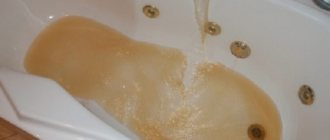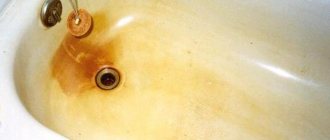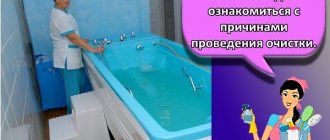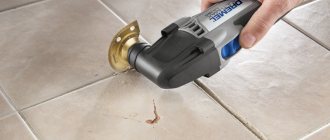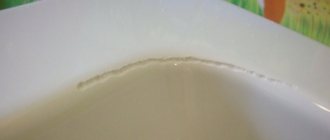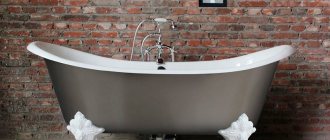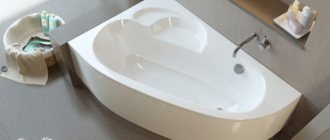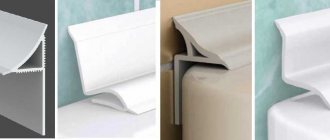When I was renovating my bathroom, I insisted on having an acrylic bathtub installed. It is so pleasant, it immediately reminds me of spa and relaxation, modern, warm and light. In general, my favorite. And then, of course, the question arose of how to clean an acrylic bathtub at home, since I wanted it to always be perfectly white and serve our family for a long time. After all, no matter what cleaning agent is suitable, it can scratch and ruin the surface. Here are my observations and tips for caring for an acrylic bathtub at home.
What should you know about the characteristics of acrylic bathtubs before cleaning them?
Before answering the question of how and what to wash an acrylic bathtub, let’s talk about the material used. Acrylic has a dirt-repellent effect: microorganisms, bacteria and fungi do not develop in the bathtub. The material is durable and resistant to impacts. A noticeable disadvantage is that it is easily scratched and subject to wear.
The main difference is exposure to abrasive and chemically active components. Like plastic, substances with high alkalinity or acidity lead to degradation of the structure, and abrasives scratch the surface, leaving deep grooves.
It is important to be careful when washing. Do not buy abrasive compounds, pastes with ammonia, chlorine, acids and alkalis. Powdered products are harmful, leaving damage and scratches. Brushes (metal and with hard bristles) are contraindicated for use.
Conclusions and useful video on the topic
The video compares the effectiveness of traditional cleaning methods (toothpaste and soda-soap solution) with household chemicals:
To maintain the impeccable cleanliness and whiteness of acrylic plumbing, there are many effective means. Available preparations do not always cope with the task, so it is better to use specialized household chemicals created taking into account the characteristics of acrylic plumbing.
Tell us what products and methods you use to care for acrylic plumbing fixtures. Share information on this issue that will be useful to site visitors. Please write comments in the block below, post photos, and ask questions.
How to clean an acrylic bathtub at home: TOP 5 ways
We have selected several options for you on how to clean an acrylic bathtub at home:
- detergent;
- lemon acid solution;
- vinegar;
- soda;
- toothpaste.
We recommend using the methods outlined above if the contamination in the bathroom is significant (after renovation, from rust). In other cases, use special liquids available on the market.
Detergents
An adequate and simple way is to use special detergents. Their cost rarely exceeds reasonable limits. For correct selection, make sure there are no abrasives. Often the ingredients are indicated on product packaging, or special notes are made.
Acrylic bathtub cleaner is used for small and large cleaning volumes . Appearing stains are removed using:
- Cif – for bathtubs, sinks, tiles and toilets. The composition does not contain abrasives, which is safe for acrylic. The reasonable price and variety of composition types (spray, paste, cream) make it a popular product among buyers. After cleaning, a film appears that protects it from further formation of limescale.
- Acrilan - foam for baths and showers. When using, leave only until completely dry, without rinsing.
- Bass is a cleaning product that is used daily. Sold in liquid form.
- Tim-Profi is an environmentally friendly product, helps fight unpleasant odors, and is effective for heavy soiling.
- Cinderella is a popular substance that emits a pungent odor, so when spraying (sold as a spray), wear gloves and a special mask.
- Chister is a composition for quickly removing dirt, promoting the decomposition of stains and grease stains. Consists of a polymer that protects against fungi.
In addition to those listed, may be used at your own risk :
- Sarma;
- SunClean;
- Luxus professional;
- LOC Plus;
- Cillit;
- Acryl – Net;
- Star – Acrylate;
- Triton;
- RAVA K;
- Panny.
Citric acid solution
Citric acid is an organic acid with a relatively high pH - a solution indicator. The materials perfectly remove plaque, grease and other contaminants. Organic acid is especially effective in affecting ordinary substances, so it is easy to clean off fat with its help. In its pure form, it has an adverse effect on acrylic, so mix it into a solution :
- Fill ⅔ full with warm water;
- Pour out half a liter of acid;
- Mix the consistency and leave overnight;
The method is effective, but aggressive towards acrylic, and it is not recommended to carry it out more than 0.5 years.
After standing for about 12 hours, the solution descends. Citric acid should be stirred more thoroughly than vinegar - completely dissolve it for further precipitation. Finally, the structure is washed with a stream of water from the shower and wiped with a soft cloth. Rub additionally to add shine.
Apple vinegar
A practical substance, but it does not always have a positive effect on acrylic. The main feature is low pH and high acidity. For a material, this factor turns out to be critical, especially if there are scratches. You should work quickly and carefully. The recommended method is to generously soak a cloth in the solution, apply it to the stain and pour water on it.
We recommend using this method at least once every six months.
In case of heavy contamination:
- Prepare 9% vinegar in an amount of 1 liter;
- Fill two-thirds full with hot water;
- Pour out the vinegar;
- Wait for the night;
- Rinse and wipe
Soda
Regular soda removes plaque. The composition has a highly alkaline environment that breaks down fats and strong compounds. In most products it is present in the form of compounds or in its usual form. There are two types: food and calcined.
Use this method once every 3-5 months.
Baking soda is a weak alkali, while calcined soda is a strong alkali, with a powerful abrasive effect. Use only baking soda .
- Place 2-3 tablespoons of baking soda on a plate;
- Pour a glass of water;
- Wet the soft side of the sponge with the solution;
- Apply the mixture by dabbing rather than rubbing;
- After 15 minutes, rinse with water and clean with a cloth.
Never use undiluted baking soda! It has a strong abrasive effect and will damage the body.
If you need to leave the surface in its original form, use distilled or filtered water. In some cities, tap water contains large amounts of calcium, which reacts with soda to form fine sand-like particles. Using water will get rid of it. The advice is also relevant for other cleaning methods involving the use of chemically active substances.
Toothpaste
Acrylic came to plumbing from dentistry - it was used for lining the frames of dentures and making crowns, so cleaning the bathtub with toothpaste is quite acceptable.
The procedure should not be carried out more than once every two months.
Buy non-abrasive paste. The manufacturer may not indicate this on the packaging. Abrasive particles are similar to small grains of sand that remove plaque from teeth, but they will greatly damage the surface of the bathtub. Before use, squeeze a small amount of paste onto your finger and rub it - the sand is immediately noticeable.
- Apply the paste to a sponge or napkin;
- Wipe the dirty surface;
- Clean with water;
- Rub until shiny
How to get rid of minor scratches and other damage?
Even with the most careful use of acrylic sanitary ware, it is often impossible to avoid scratches on their surface. In such damage, lime and rust deposits can accumulate, which immediately visually distinguish these areas from the general background. To get rid of scratches, you can use one of the existing methods for removing them.
Sanding scratches using fine sandpaper
- Shallow scratches can be removed in the same way as single rust spots by treating the surface with fine-grained (P240÷P280) sandpaper. After which the leveled area is polished with a polish specially designed for acrylic.
Polish for acrylic surfaces.
- Sometimes it is quite enough to apply only polish to scratches, without using preliminary abrasive action. The polishing paste is applied and intensively rubbed into the surface using a piece of felt in a circular motion. The process is continued until the scratches and the applied composition are smoothed to the maximum.
Repair kit for restoring damaged acrylic plumbing fixtures.
- If deep damage occurs, a repair kit for acrylic plumbing accessories will help. It is recommended to purchase it along with the bathtub in order to immediately select the closest shade of color - this will be much more difficult to do later. The kit includes a paste-like acrylic compound that hardens when applied to the surface of the bathtub. Fill the scratches with the paste and rub it in in a circular motion using felt until smooth.
The process of repairing an acrylic bathtub using putty.
- With paste acrylic you can even repair through holes in a cast bathtub model, which can also form for one reason or another. To perform this procedure, you must first clean the area being repaired. Next, several layers of high-quality waterproof tape are glued to the outside of the bathtub, which will become a barrier for the paste. Then the resulting hole is filled with liquid acrylic and leveled using a plastic spatula. After which the patch must be left until the paste hardens for two to three hours. Next, the acrylic is sanded with fine-grained sandpaper and polished with a piece of felt.
- The method of pouring acrylic can also be used in cases where it is necessary to remove deeply ingrained stains, after the elimination of which depressions remain on the surfaces.
- Another option for sealing through holes in a bathtub involves the use of polymer putty. They fill the resulting hole with it and wait until it dries completely. After that, acrylic paste is applied on top of the putty and leveled with a spatula. The dried paste is processed with fine-grained sandpaper, then, if necessary, painted, and the final action is to finely polish the area to a perfectly smooth state.
It is quite obvious that, if desired, the owners can not only carry out regular cleaning, but also restore damaged areas of acrylic bathtubs without resorting to the help of a specialist.
Prices for popular acrylic bathtubs
Table: type of contamination - cleaning recommendation
Let's look at the main ways to clean an acrylic bathtub:
| Problem | Solution |
| From yellow spots | Tooth paste. Cleans acrylic and returns its whiteness. |
| Rust | Soda. The structure does not scratch, but will cope with serious stains. |
| Sealant | Lemon juice. Corrodes any mixture, including sealant. |
| Limescale | Vinegar. It should be used rarely, but it does a good job of removing plaque. |
| Glue | Lemon acid. |
Preventive measures for the future
No matter how effective the cleaning product, store-bought or home-made, the best way to get rid of limescale in the bathroom is regular cleaning and care of the plumbing. There are several simple ways to prevent mineral deposits from appearing:
- Ventilate your bathroom regularly
- Clean at least once a week with professional or folk remedies.
- After bathing, do not be lazy to rinse and wipe the acrylic bathtub dry
- Monitor the working condition of the plumbing and avoid leaks
- Install additional purification filters if the water in your region is very hard
- Do not leave metal objects in the bath to avoid rust and mechanical damage.
Contraindications: what not to use when cleaning
A few words about how not to clean an acrylic bathtub at home. We do not recommend using:
- Acetone - corrodes plastic and causes holes to appear.
- Abrasive substances damage the surface, leaving scratches and reducing the thickness of the enamel.
- A mixture of several components creates the opposite effect, scratching the walls.
The appearance of acetone in the room should be completely eliminated. The element is chemically active and acts as a solvent. 10-20 ml is enough to make a dent on the surface of the structure.
Wash off active chemicals with cold water. High temperature increases the reaction rate and surface damage will occur faster.
Industrial cleaners
When cleaning an acrylic bathtub, you can use only those preparations that do not contain aggressive or abrasive substances. You should use tools that have a high user rating.
The most effective and popular cleaning products suitable for cleaning acrylic coatings include:
- "Acrilan".
- "Silit Beng".
- "SIF Active"
- Unicum.
- Comet.
- "Chistin."
Unicum comes in spray form, making it easy to apply. It contains a high concentration of the active substance, which contributes to economical consumption.
The product allows you to eliminate fungus in the bathroom and rust stains on plumbing fixtures.
Comet Expert is also available in spray form. It helps remove even severe stains. It contains formic and phosphoric acid. The product should be applied to the acrylic surface for about 3 minutes. Prolonged exposure may compromise the integrity of the coating.
Household cleaner "Acrilan".
"Akrilan" is produced by the Israeli manufacturer Bagi. This product is highly effective in removing lime stains and rust. The drug is packaged in a plastic container equipped with a spray bottle. When sprayed, a thick foam forms, which should be left for 2-3 minutes, then rinsed off and wiped the surface with a clean cloth.
Silit Beng contains hydrochloric acid and therefore requires caution when used. The product effectively removes rust, salts and stains. The bath should be treated with this preparation and left for 3 minutes, and then removed.
"Cif Active" comes in the form of a cream, so it does not leave scratches. It removes traces of lime, rust and other contaminants. The cream is applied to the surface and left for 2-3 minutes.
Compatibility of detergents with acrylic surfaces
Is it possible to wash an acrylic bathtub with Domestos or a mixture of substances? It is not advisable to mix with:
- Formaldehyde - they are not compatible with acrylic.
- Chlorine - its use forms pores, shortening the service life of the product.
- Acetone , ammonia - corrode the walls.
Domestos, Sanox, Pemolux and Selite contain hydrochloric acid, which destroys protection. Initially, it is bleached, but then it absorbs plaque, becoming dirty faster. Therefore, such detergents cannot be used.
Disinfection with white
An acrylic bathtub is a way to forget about fungus forever, but it’s not ideal either. The fungus does not appear on the material, but easily multiplies on plaque, fats and other organic substances with nutritious microflora. Contamination should not be allowed to appear for a long time, and if it does appear, complete disinfection should be carried out periodically.
Fill the bathtub with water at room temperature;
- Add 2 liters of white (7%);
- Do not touch for 10–15 minutes;
- Rinse off the water and refill;
- Remove any remaining bleach and drain the water;
- Wipe dry with a cloth.
Features of acrylic products
Intricately configured sanitary ware allows you to create a unique interior in large and small bathrooms. It makes it possible to emphasize the individuality of the owners, adds comfort and brings a special atmosphere with its very presence.
What is a bath?
An acrylic bathtub, in addition to its original shape, has its positive and negative sides, which must be taken into account during its operation and maintenance.
So, you should immediately make sure which product you are going to live with side by side - a cast acrylic structure with a thickness of 5 mm or more, or a 1- or 3-layer plastic variation covered with a 2-3 mm layer of acrylic.
If we are talking about the first option, then there will be no doubt about the impeccable quality of the product. The manufacturer will confirm this by providing a 10-25 year guarantee on acrylic.
In the second case, you will have to make friends with a thin coating, which will last for 3-5 years, and maybe even 10. This depends on the specifics of use and the promises of the company that made the bath.
We will not consider the option of a parody of an acrylic product with a top layer of 0.5 mm - a bad fake cannot be called an acrylic bathtub. The coating will wear off after 6-8 months of use.
In addition to the thickness of the acrylic layer, the difficulty of cleaning is influenced by size and functionality - the larger the bowl and the more pleasures it can offer, the more difficult it is to clean.
As for additional functions, acrylic models are equipped with hydromassage equipment, lighting, sound effects and other interesting devices.
It turns out that the original shape of the bowl, non-standard size, and many nozzles will influence the complexity of the procedures for caring for it. And the more additional equipment, the more time will need to be devoted to washing and disinfecting the product.
What's wrong with an acrylic surface?
It is important to carefully read the manufacturer’s recommendations after purchasing a bathtub. The fact is that many companies provide a guarantee on acrylic coating and all kinds of equipment only if certain rules are observed.
Thus, sometimes the instructions indicate that the warranty begins to apply only after installation of the product by a responsible employee of the company from which it was purchased. It turns out that if you install it yourself, you can lose the 10-year warranty.
Another feature that you should definitely pay attention to before starting to use the bath is the manufacturer’s recommendations for its operation. It is this section that needs to be carefully studied so that in the future you do not lose the product and the guarantee that the problem will be corrected at the expense of the seller.
A polymer bathing container is significantly different from its steel and cast iron counterparts - it requires a more careful attitude. Especially if the acrylic layer is very thin.
The acrylic thicket is afraid of fire, hot water, aggressive chemicals, prickly and sharp things and other troubles. To extend its life, you need to carefully monitor your actions in relation to the acrylic bathtub.
In addition, manufacturers are categorically against bathing animals in the bowl - it should only be used for personal hygiene. Therefore, scratches from claws that spoil the appearance of the product are not covered under warranty.
The way out of the situation is to have a special bedding for your pet’s water treatments. It can be a soft thick towel or a silicone mat. Before bathing, it should be placed on the bottom of the bath. True, such a device will not protect against scratches on the sides.
Rules for proper use
The bath does not require serious care, but it is still necessary to follow the rules.
- Periodically bringing the plumbing to a decent condition in 5 minutes - after water procedures, rinse with clean water . Acrylic does not absorb dirt, so this type of washing is sufficient.
- After use, wipe the bathtub with a sponge and soapy water . Next, dry to avoid streaks.
- restoration kits for removing scratches - they are sold in hardware stores.
The nuances of cleaning a bowl with hydromassage
Systems with a hydraulic massage function are equipped with nozzles connected to a compressor and a circulation pump. The technique creates excess pressure of the water flow, which comes out under pressure through the sprayers in the hot tub.
With regular use of the hydromassage option, the nozzles do not have time to dry out - constant humidity provokes the proliferation of microorganisms, mold growth and the accumulation of lime deposits.
Recommended cleaning frequency: if the sprayers are used every day – weekly, if the hydromassage is turned on rarely – monthly. An appropriate disinfectant is selected for disinfection
The procedure for carrying out the disinfection procedure:
- Fill the tank with water so that the nozzles “go” 5-7 cm under water.
- Pour the cleaning concentrate into the bath and turn on the hydromassage for 20 minutes - the liquid should make several circular cycles through the system.
- Drain the water and refill the bowl.
- Turn on the sprayers for 5 minutes and empty the bath.
Upon completion of the procedure, it is necessary to perform standard cleaning of the walls and bottom of the “font”.

